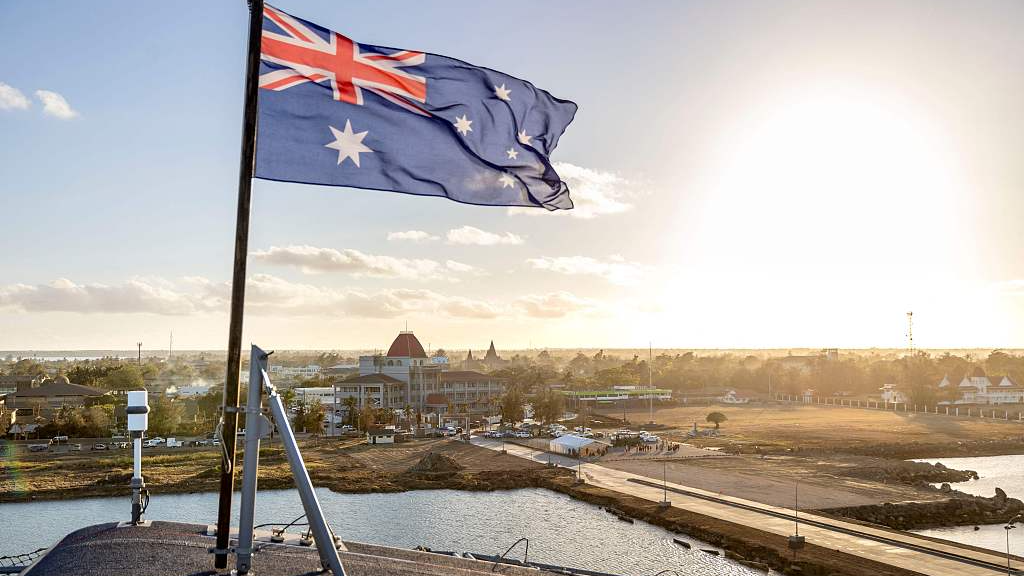
The Australian flag flying on board the HMAS Adelaide as the ship arrives in Nuku'alofa, Tonga, January 26, 2022. /CFP
The Australian flag flying on board the HMAS Adelaide as the ship arrives in Nuku'alofa, Tonga, January 26, 2022. /CFP
Editor's note: Abhishek G Bhaya is a senior journalist and international affairs commentator. The article reflects the author's opinions and not necessarily the views of CGTN.
It is common knowledge that Australia is a key U.S. ally and is at the forefront of implementing Washington's so-called Indo-Pacific security strategy that evidently has countering China's increasing geopolitical and economic influence as its fundamental objective.
That strategy is increasingly driving Australia to follow in the footsteps of the U.S. in creating regional military and trade alliances with an eye to curbing China's presence in the region.
In line with that overarching strategic goal, Australian Defense Minister Richard Marles on Tuesday met his counterparts from South Pacific nations to seek closer military ties with the three island nations – Tonga, Papua New Guinea (PNG), and Fiji.
"Australia will be there as a partner and a friend, as together we confront common threats to our collective security, including climate change, transnational crime, cyber-attacks and natural disasters," Marles, also Australia's Deputy Prime Minister, said in a statement after attending the South Pacific Defense Ministers' Meeting (SPDMM) in Tonga.
This was the first in-person SPDMM to be held since 2019. Besides the three South Pacific island countries and Australia, the framework also includes New Zealand, Chile and France, which maintains a military presence in its South Pacific territory of New Caledonia. The U.S., UK and Japan are observer nations.
At the face of it, the SPDMM was a regional defense cooperation meeting, but Australian and Western media reports concluded, and perhaps rightly so, that it was yet another strategic move aimed at countering "China's security push in the region."
While China has often repeated that it doesn't mind countries engaging in military cooperation, Beijing has also stressed that such cooperation shouldn't be aimed at another country. "We hope that military cooperation between relevant countries is conducive to regional peace and stability and will not target any third party," Chinese Foreign Ministry Spokesperson Wang Wenbin said, responding to a question regarding the SPDMM a day ahead of Tuesday's meeting.
Militarizing the Pacific region
The Tonga meeting also signaled Australia's plan to incorporate the island countries into a regional defense bloc – a plan that was unveiled during Marles' PNG visit earlier this month – and to enlist Pacific islanders to act as cannon fodders in the West's likely confrontation with China in future.
As per the proposal, the military forces of the South Pacific island countries will attend a warfare training school in the northeastern Australian state of Queensland and will also be deployed with the Australian Defense Force (ADF) for military exercises and support missions. This will be similar to the current process of Australian military personnel serving in the U.S. and British forces.
Soldiers and officers from the Pacific countries have also been given the offer to be embedded into the Australian army under Australian command.
"I'm keen to make it simpler and easier to deploy together – on land and at sea, when disaster or crises strike – so that it becomes our default arrangement," the Australian Defense Minister said in his official statement after Tuesday's meeting.

Australian Deputy Prime Minister and Defense Minister Richard Marles' proposed strategy is an unmistakable attempt to militarize the Pacific region and incorporate the island countries to serve Australia's strategic targets, as defined under the U.S.'s Indo-Pacific Strategy. /CFP
Australian Deputy Prime Minister and Defense Minister Richard Marles' proposed strategy is an unmistakable attempt to militarize the Pacific region and incorporate the island countries to serve Australia's strategic targets, as defined under the U.S.'s Indo-Pacific Strategy. /CFP
The strategy proposed by Marles is an unmistakable attempt to militarize the Pacific region and incorporate the island countries to serve Australia's strategic targets, as defined under the U.S.'s Indo-Pacific Strategy.
Reports suggest that ADF is already studying a proposal to set up a Pacific Regiment within its fold. Pacific islanders would be directly recruited to join the ADF under this proposal. "Australian and U.S. ties with Pacific island countries will be the key to success or failure in a war with China over Taiwan [region]," the Australian newspaper reported on October 13, in a clear sign as to the motives and objectives of the plan.
It is also clear that Canberra is taking a leaf from Washington's strategy, and perhaps acting on its behest, in forging small regional allies as it projects itself as a military hegemon in the South Pacific with a focused aim of containing China.
Australia is a member of the Quadrilateral Security Dialogue, or Quad, alongside the U.S., Japan and India. Along with the U.S. and the UK, it has formed a trilateral military alliance dubbed AUKUS.
Australia is also a part of the Indo-Pacific Economic Framework for Prosperity (IPEF) which includes the four Quad members, seven Southeast Asian countries – namely Brunei, Indonesia, Malaysia, the Philippines, Singapore, Thailand and Vietnam – the Republic of Korea, New Zealand and Fiji.
The common thread in these U.S.-led groups remains implicit, yet well known – their strategic goal to contain China's economic and military might and a drive to reconstruct the global supply chain network without China.
Strategic significance
The Pacific Islands Countries (PICs) have long been ignored by the West. In contrast, ties between China and PICs have steadily strengthened since the establishment of diplomatic ties in the 1970s.
Chinese President Xi Jinping made two visits to the South Pacific region in 2014 and 2018 and held meetings with leaders of PICs having diplomatic ties with China, which opened a new chapter in the history of China-PICs relations. Earlier this summer, China's State Councilor and Foreign Minister Wang Yi visited the South Pacific Island Countries and chair the second China-Pacific Island Countries Foreign Ministers' Meeting.
The deepening of ties between China and PICs seems to have awakened the U.S. and its allies, including Australia, to the strategic significance of the island countries. In July, Washington announced a series of initiatives to deepen U.S. partnership with the region culminating in U.S. President Joe Biden hosting the first- ever U.S.-Pacific Island leaders' summit in late September. One of Biden's key commitments was to include the Pacific Islands in the Indo-Pacific strategy.
The latest Australian outreach to South Pacific Islands is an extension of that same plan, and a ploy to contain China. However, the success or the failure of the strategy hinges on how much, or if at all, the island countries are willing to serve as cannon fodders in the U.S.-led confrontation against China in the Indo-Pacific, spearheaded by Australia.
(If you want to contribute and have specific expertise, please contact us at opinions@cgtn.com. Follow @thouse_opinions on Twitter to discover the latest commentaries on CGTN Opinion section.)